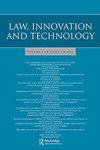Artificial intelligence and legal disruption: a new model for analysis
Q1 Social Sciences
引用次数: 21
Abstract
ABSTRACT Artificial intelligence (AI) is increasingly expected to disrupt the ordinary functioning of society. From how we fight wars or govern society, to how we work and play, and from how we create to how we teach and learn, there is almost no field of human activity which is believed to be entirely immune from the impact of this emerging technology. This poses a multifaceted problem when it comes to designing and understanding regulatory responses to AI. This article aims to: (i) defend the need for a novel conceptual model for understanding the systemic legal disruption caused by new technologies such as AI; (ii) to situate this model in relation to preceding debates about the interaction of regulation with new technologies (particularly the ‘cyberlaw’ and ‘robolaw’ debates); and (iii) to set out a detailed model for understanding the legal disruption precipitated by AI, examining both pathways stemming from new affordances that can give rise to a regulatory ‘disruptive moment’, as well as the Legal Development, Displacement or Destruction that can ensue. The article proposes that this model of legal disruption can be broadly generalisable to understanding the legal effects and challenges of other emerging technologies.人工智能与法律破坏:一种新的分析模型
人们越来越期待人工智能会扰乱社会的正常运转。从我们如何打仗或治理社会,到我们如何工作和玩耍,从我们如何创造到我们如何教学,几乎没有一个人类活动领域可以完全免受这一新兴技术的影响。当涉及到设计和理解对人工智能的监管反应时,这提出了一个多方面的问题。本文旨在:(i)为理解人工智能等新技术造成的系统性法律混乱提供一个新的概念模型的必要性;(ii)将这一模式与之前关于监管与新技术相互作用的辩论(特别是“网络法”和“机器人法”的辩论)联系起来;以及(iii)制定一个详细的模型来理解人工智能引发的法律混乱,研究可能引发监管“混乱时刻”的新可供性产生的两种途径,以及可能随之而来的法律发展、流离失所或破坏。文章提出,这种法律破坏模式可以广泛推广,以理解其他新兴技术的法律影响和挑战。
本文章由计算机程序翻译,如有差异,请以英文原文为准。
求助全文
约1分钟内获得全文
求助全文
来源期刊

Law, Innovation and Technology
Social Sciences-Law
CiteScore
4.50
自引率
0.00%
发文量
18
期刊介绍:
Stem cell research, cloning, GMOs ... How do regulations affect such emerging technologies? What impact do new technologies have on law? And can we rely on technology itself as a regulatory tool? The meeting of law and technology is rapidly becoming an increasingly significant (and controversial) topic. Law, Innovation and Technology is, however, the only journal to engage fully with it, setting an innovative and distinctive agenda for lawyers, ethicists and policy makers. Spanning ICTs, biotechnologies, nanotechnologies, neurotechnologies, robotics and AI, it offers a unique forum for the highest level of reflection on this essential area.
 求助内容:
求助内容: 应助结果提醒方式:
应助结果提醒方式:


